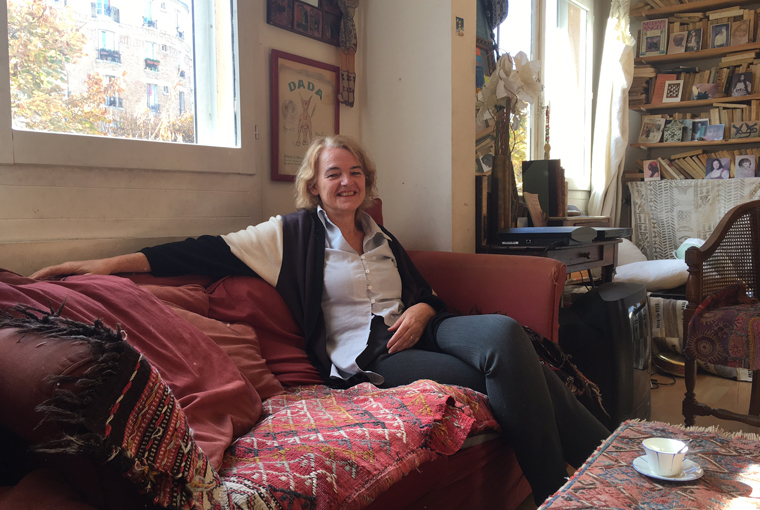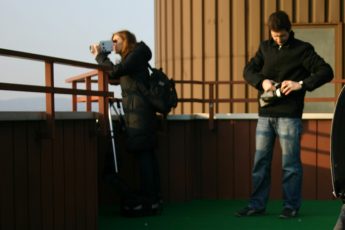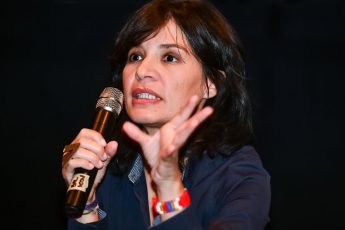
We sat down with Catherine Coquio on the occasion of our war-themed issue (Nov ’16). Author to several books on memory culture and professor of comparative literature at the Diderot University Paris, Coquio elaborates on her critique of culture industry, whose handling of the past is framed in terms of grief and sanctification which she thinks make it unrelatable to political and social reality.
In your latest books, “Le mal de vérité” and “La littérature en suspens”, are conspicuous a disenchantment and skepticism, sometimes even anger, regarding the current drift of our memory culture. Throughout “Le mal de vérité”, we repeatedly encounter formulas such as: “a lure,” “Neo-Christian pathos,” “jargon of authenticity,” “addiction to memory as a civilization crisis,” “memory has replaced politics,” “cathartic storytelling,” “our kitsch,” “today’s spleen,” “collective mythology,” “religion of memory,” “ersatz and screen,” etc. Can you tell us more precisely where these feelings spring from?
What I call “memory culture” designs a process different from what Maurice Halbwachs called “collective memory” or Jan Assman called “cultural memory”. It is a culture that incorporates historical violence as its working material, and which yields both symbolic benefits, e.g. a clear conscience, and material benefits. I think we ought to take seriously Walter Benjamin’s idea that there is no document of culture which is not at the same time a document of barbarism, and we have to include the documents of memory culture. These forms of complacency and institutionalization, show a lack of conscience regarding the often-crude ideologization and instrumentalization of memory. But my being angry is also a form of self-criticism, a way to protect those parts of my own work that might be misunderstood, even if I never embraced the notion of a “memory work,” let alone “duty of memory,” which I’ve openly criticized.
Is this the reason why you do not adhere to memory studies?
Part of memory studies I find interesting, like Marianne Hirsch’s postmemory and Michael Rothberg’s multidirectional model, but I think we have to put the finger where it hurts―not only in colonial history, but in the Middle-East. What I’m working on right now is what I call a “memory differend” (in Lyotard’s sense) between the East and the West, meaning the huge deafness that keeps us apart, which is blatant in memory studies. There is often a sort of sociological reductionism in memory studies. As I see it, this sociological stance, important as it is, doesn’t go far enough. Describing memories as fields or conflicts between “memory groups” or “minorities” is not enough. And it is quite a depoliticized thing to do, too. What we need is a critique of memory culture that asks what is politically done about it and with it in the present, e.g. when you look at Syria, or France after the terrorist attacks. A close reading of texts and testimonies with current political developments, historiography, etc., though, can only be achieved through a huge interdisciplinary and collective endeavor.
How was your interest for mass violence first spurred? How come you decided to devote your life to such research?
It is through literature that I stumbled upon these matters. During the 90s, I was reading literary testimonies like those of Primo Levi and Varlan Chalamov and many others, and poetry of Paul Celan, after having read and studied the fin-de-siècle Decadent movement from Baudelaire onward and critical nihilism, and then German and Austrian great analysts of cultural European crisis (including Benjamin, Kafka, Kraus, Musil, Broch, Bloch). I created a group to study the forgotten and important work of Mécislas Goldberg, a Polish Jew who came in Paris in 1894 and became an anarchist thinker and poet in France, from where he was twice expulsed: discovering the violence of french antisemitism I read Leon Poliakov in parallel to Walter Benjamin and Gershom Scholem. During those very years new episodes of mass violence were taking place―like Srebrenica, the Tutsi genocide in Rwanda, or the bloodbaths in Algeria like in Bentalha. Such political developments, mixed with my readings, made me very anxious. So I started an association to study the repetition of genocidal violence in our societies, AIRCRIGE, which lasted until 2008-2009. At the time there was no room in the University for this kind of research. To speak about genocides in plural form was a most contentious, almost forbidden, matter.
Those were the years of the representability debates.
Exactly: the Shoah’s representability and uniqueness. These ideas were, in my opinion, way too monolithic and simplistic. I was shocked by the violence of public debates, which I had to endure myself―for example when Claude Lanzmann attacked me and my team when we organized the symposium “L’homme, la langue, les camps” in 1997.
In sum, I got into politics without having ever belonged to any party or syndicate. A need for freedom led me to engage in a critique of the memory culture we live in. We have to reimagine in our different situation the critique of culture initiated by Critical theorists like Benjamin or Adorno. I felt the need for a critique of the social myths built around Memory with a capital M, of the political instrumentalization of memory and testimonies, and of the contemporary sacralization of testimonies. All these phenomena I find quite troubling, since I have myself contributed through my work to the institution of testimonial writing as a critical category and a vital instrument to understand political and mass violence and their denial. One of my main preoccupations is how to protect my own work against this kind of instrumentalization and catechization.
Can you be more explicit about the ideologization process? Why do you say memory has become a religion? And could you tell us more about the two complementary processes you write about, the “enshrinement of memory” and the “sublimation of testimony,” which you consider as the pillars of memory culture?
It is a complicated process. Besides, one has to be cautious, as there actually is a sacred element in the bereavement process for those who died by mass violence. When one bears testimony, one relates to what I call the “peuple des morts”, the community of the dead. There is, therefore, a sacramental and funeral dimension to testimonial literature, which cannot be ignored. This literature plays with mourning rituals, or tries to invent its own rituals.
Another sacred element is present in the act of bearing testimony, which was at first a juridical and religious category. When you bear testimony, you take an oath to tell the truth and an oath before God. A testimony is thus a kind of promise, and so is linked to the sacred. This dimension has to be carefully distinguished from our memory culture, which promotes a kind of moral church that makes people believe they can become testimonies by reading testimonial literature. Which is of course an aberration. Because this desire to become a testimony by any means in the end erases all that is disruptive in the true testimonies of “disbelonging,” like Jean Améry or Imre Kertész, which blow to pieces this cultural regulation of memory. The cultural process we’re living through has nothing to do with that anymore. We’re in the showbiz society applied to the field of memory.
Let us quote a passage: “Under this unique word [memory] fuss the chaos of individual grief and struggles for recognition, a state ideology instituted at the European level (the ‘duty of remembrance’), and a prosperous cultural market.” That’s what we think is really sharp in your work: you keep alive this distinction between the culture industry built around memory and the promise made to the dead, which we cannot break.
The latter has to do with truth. The dead are entitled to truth, but then so are the living. Truth is here the possibility to reconstruct the sense of what actually happened. When an episode of mass violence occurs, not only reality, but also sense and subjectivity are obliterated, denied or destroyed. Without taking this seriously, you cannot understand the obsession with truth and memory in both survivors and descendants. There is indeed, in a way, a sort of sacralization or sanctification of truth, but not of the sort decried by Derrida as a philosophical longing for truth.
That’s what I call “mal de vérité”, “truth fever.” It is caused by very specific operations, which are politically administered but have deep anthropological side effects. The disease or obsession with memory shouldn’t just be politically and culturally criticized. It should be understood in the context of the former violence that engendered this hollowness, this hole we’re falling into, and which in turn engenders a crisis of truth within democracy, as well as endless controversies and misunderstandings that have to do with who’s entitled to talk about reality and tell the truth. Is it judges? Historians? Survivors? Second or third generation testimonies, as we have them today? And what kind of truth does each of these figures convey?
What I’m interested in is the part of subjective experiences and the power of language in the way of understanding historical violence. What I try to understand is what did those who underwent such destruction of sense and reality through widespread lying in politics think about truth, memory, catharsis. I consider the texts of writers like Julius Margolin, Chalamov, Kousnetsov, Kertész, not as tokens of memory or human or ethical documents, but as actual precious and rare reflections upon those very notions.
And when I talk about a “utopia of memory,” I think of a sort of reversed Principle of Hope, to take up Ernst Bloch’s formula. What I mean is that we’re so lacking in political horizons and hopes that we tend to search in testimonial literature that which, even if those people went through the worst, would point towards a life proposition and an opening of the future. What I think, instead, and what I think these texts are really telling us, is that we have to drop our humanistic dreams if we really want to reopen a horizon and a future.
Which is exactly the opposite than what the culture industry does.
It is the opposite, yes, a sort of piety and sanctification, which changes nothing in political and social life.
But is it a matter of representation or reception, interpretation? If there is a problem of “memory work,” can we do something about it by reviewing our tools, our methods?
To me, that’s what critical thought is all about. But I don’t think that criticism has or should have political power. All we can do is fulfill a strong critical requirement regarding the document of culture that memory has become. And personally I want to do it through a very close reading of the texts, as in Jean Bollack’s critical philology or hermeneutic, which is always attentive to ideological abuses and political effects in interpretations. On the other hand, we ought to be attentive to what’s going on right now. Take Aleppo: how come we have been doing nothing since 2011? How could such inertia settle in? And what I think is really dangerous, too, is to turn social change, revolution, or insurrection, into a cultural object. Here, too, we fall prey to showbiz, and we are depoliticized. And this is even more troubling in our days than the so-called “culture of horror,” even if they both go hand in hand.
What we’re interested in, more precisely, are the 1990s in Eastern Europe. There was an opening of the archives and the wake of a memory that wasn’t there before, together with a political reorientation towards the West, in which memory culture, mainly Germany’s, was incorporated in a copy-paste operation ― which is crystal clear in Poland, the Czech Republic, as well as in the Baltic countries. But to whose profit?
This is a delicate issue. I actually think it’s a good thing that the memory revolution occurred in Poland, with its past and present history of anti-Semitism. The first public words during the 80s were really explosive. I think memory culture is first and foremost a Western phenomenon. Now a different process is settling in, in Poland and elsewhere: dark tourism. It is sometimes quite shocking, but it is also inevitable, part of the neo-capitalist phenomenon, as it was inevitable that industrial society should make Nazi movies and a lot of money with this kind of objects. What I’m worried about right now is that, in places like Poland, memory culture is a way to say no to an egalitarian revolution, which is seen as inherent to the history of Communism and Communist crimes, the only alternative to which would be liberalism as we have it today. This is the underlying problem: the melancholy of the left, which makes memory culture completely ambivalent and ambiguous. For example when you have, on the one hand, a fight to install a plate telling us about deportation in this or that square, but then, on the other hand, an almost total passivity towards catastrophic events that are happening right now.
That’s what we’d like to go back to. Once you turn critical thought into positive action, e.g. by making a film about the Holocaust or Polish guilt complex, and this film becomes a symbol for “good Eastern European citizens,” you wipe out the critical element. That’s an inevitable problem, and it is the case e.g. with “Son of Saul“, which is refined up to the way it integrates the reaction of the public.
It is a film that integrates ten years of historical research about the Shoah. You find everything in there. It is a striking film, formally coherent and powerful, made by a very young man. Striking, too, is the the lack of critical debates about it, Didi-Huberman’s book being made into a promotional item. The issue is how to produce texts, works, which are not ambiguous, which provide their own antidote.
One of your references is Imre Kertész. Don’t you think that Kertesz has been ambiguous at times?
Politically, yes. At the end of his life, his discourse turned very rightwing. I was very disappointed by some of his last interviews and by his last book. His violence against leftist Jews is unacceptable, as is his anti-Communism or when he justifies the politics of Israel. But for me Kertész’s earlier writings, and above all The Holocaust as Culture, are unambiguous.
Is it really possible for a work of art to foresee its own reception? One could imagine that even the most self-consciously critical film or novel could still be misinterpreted as a cathartic effigy of hope…
Of course, it’s imaginable. I have experienced it myself. If you don’t know what I’m talking about, you may believe – just by reading the title – that my book is yet another dutiful treatment of the Holocaust. But if you really read the book, it’s impossible not to understand its criticism. You can always try to be as unambiguous as possible.
One could say that “Son of Saul” tried to incorporate its own criticism in every way…
…but that it was turned into a pedagogical instrument. That’s really unacceptable!
And because there has never been a film that was historically more accurate. But perhaps the film places its historical accuracy in a blurry background, precisely to foresee criticism – like that of Claude Lanzmann who praised the film for having “been wise enough not to represent the Holocaust”. And yet the film also pleases Georges Didi-Huberman who used to criticize Lanzmann for his iconoclasm…
It’s a historical ecumenism! That’s very worrying indeed. But what is even more worrying is that the film is taught in schools and that children are completely overwhelmed dealing with so much atrocity. I think it’s much more important for children to be able to learn to live in this world and face the reality of today.
In this respect it is interesting that the film’s plot is centered on the act of mourning – the father looking for a rabbi for his son – and not on the revolt in the camp. The collective revolt is a subplot, but it fails and so doesn’t interest Saul. Son of Saul sublimates the individual act of mourning.That’s a choice. Ethical, not political. Which might make its pedagogical use problematic, too. Of course, choosing revolt over mourning could also be instrumentalized, but the film erases the fact that many of these resistant Jews were revolutionaries or of the far-left. But this part of history seems now completely forgotten or secondary, like a folklore, or nothing at all. Read Who will write our story?, the beautiful book of Samuel Kasow about Emanuel Ringelblum’s underground archive in the Warsaw ghetto, as a collective resistance up to the end. It could perhaps help us to rethink politically… .
One of your references is Imre Kertész. Don’t you think that Kertesz has been ambiguous at times?
Politically, yes. At the end of his life, some of his discourse turned very rightwing. I was disappointed by some of his last interviews and by his last book. His violence against leftist Jews and their criticism of the politics of Israel is unacceptable. We recognize here the effect of 30 years of Hungarian Communism. But for me Kertész’s earlier writings, and above all Journal de galère and The Holocaust as Culture, are unambiguous, without any complacency for humanity and himself.
Some people may think that his irony is unwarranted…
Yes, like Baudelaire’s irony! Why unwarranted? Well, everything in Kertész is ironic. Irony is his art. What makes his critical writing extraordinary is that he always considers himself a prisoner of memory culture. He always applies criticism to his own writing. He plays with himself and with us, to make himself and us more clever, and happier, too.
Thank you for the interview.




Leave a Comment